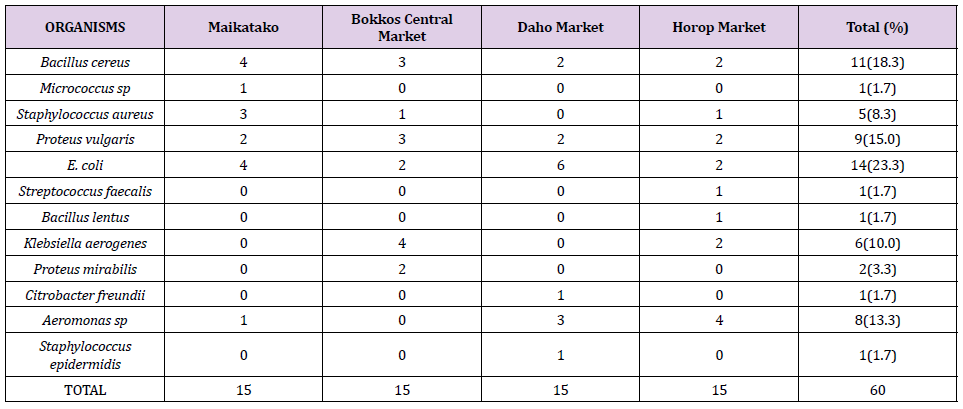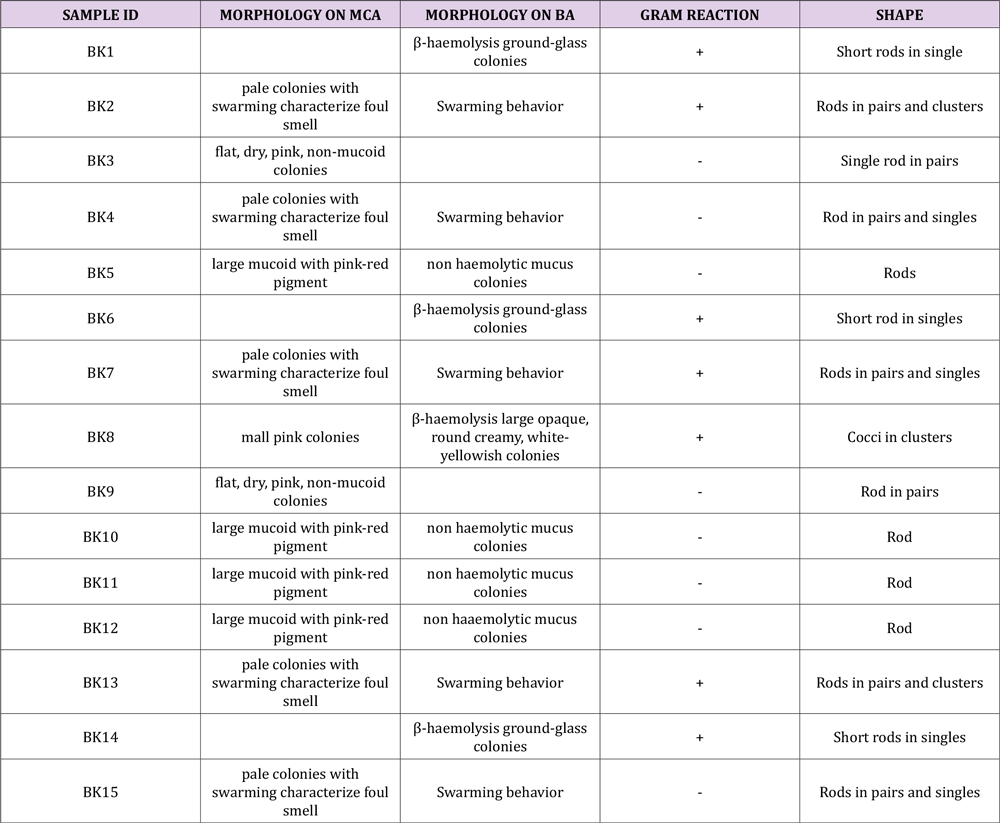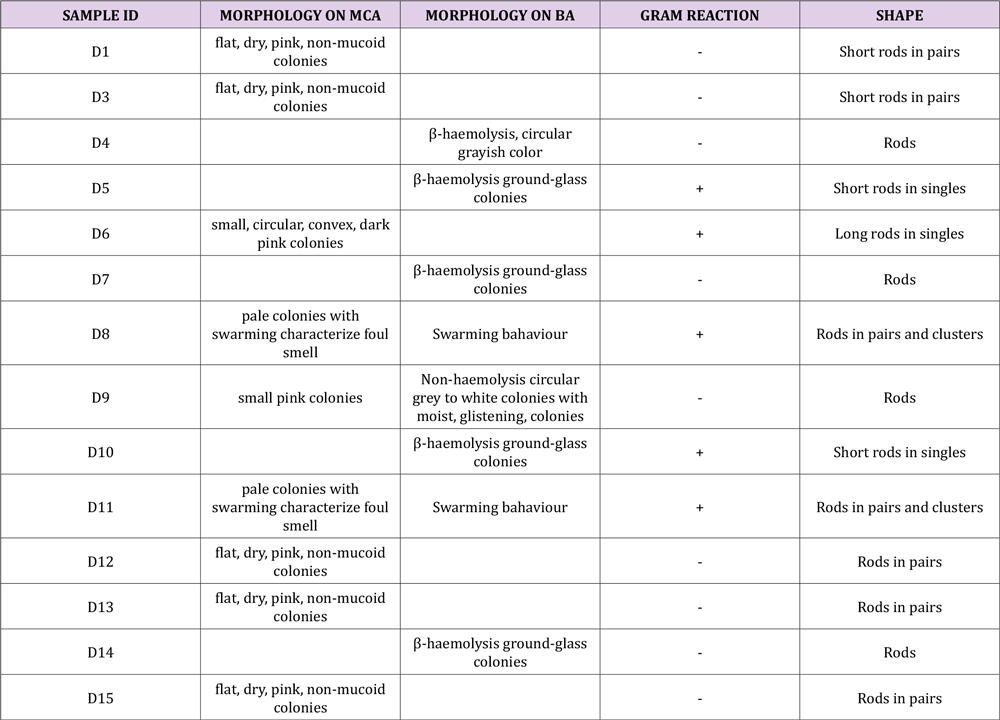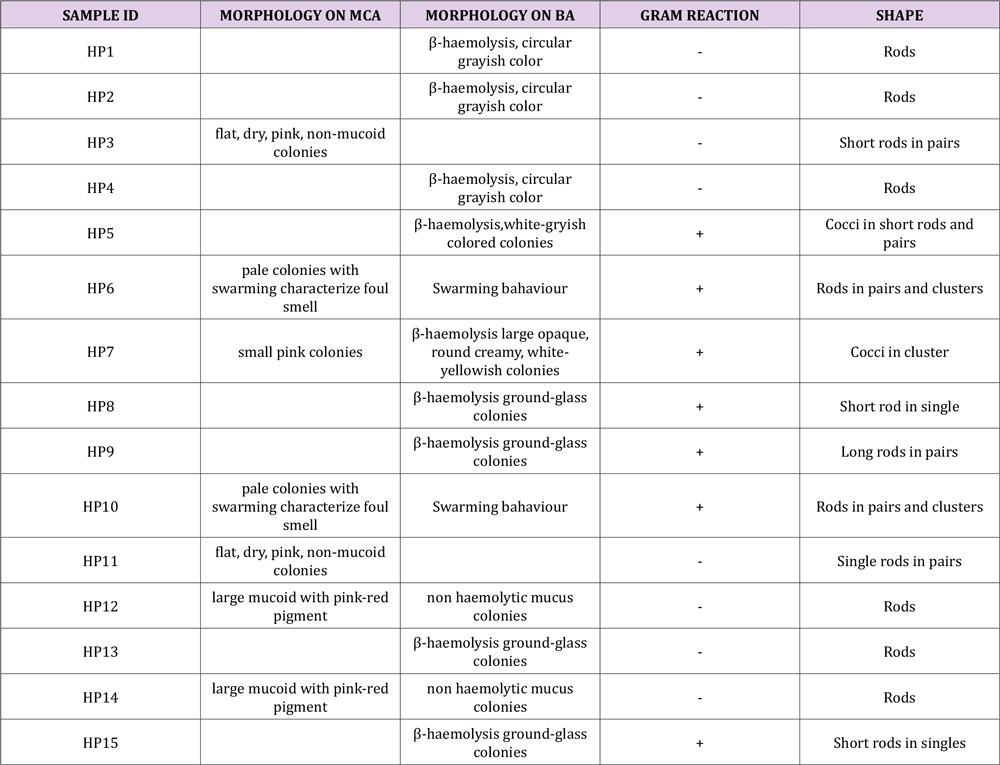Impact Factor : 0.548
- NLM ID: 101723284
- OCoLC: 999826537
- LCCN: 2017202541
Musa Filibus Gugu1*, Joshua Kuretmunan Bermang1, Pwajok Yakubu Mwanja1, Akwashiki Ombugadu2 and Victor A Adejoh2
Received: October 06, 2022; Published: October 26, 2022
*Corresponding author: Musa Filibus Gugu, Department of Microbiology, Faculty of Natural and Applied Sciences, Plateau State University, P. O. Box 2012, Bokkos, Nigeria.
DOI: 10.26717/BJSTR.2022.46.007406
Meat is a rich source of protein, vitamins, and mineral salts. However, it is perishable due to its ability to support the growth of various microorganisms. Therefore, this study was conducted to isolate and identify bacteria associated with ‘Suya’ meat in Bokkos Local Government Area of Plateau State. A total of 60 suya samples (15 from each location) were purchased from four different locations (Maikatako Market, Bokkos Central Market, Daho Market, Horop Market) within Bokkos local government for bacteriological analysis. One gram (1g) of each sample (suya meat) was inoculated into buffered peptone water and incubated at 37°C for 24 hours. Suya meat samples were plated on MacConkey and blood agar and incubated at 37°C for 24 hours. Single colonies were observed, and each colony was Gram-stained and examined microscopically. Biochemical tests were performed to confirm the presence of bacteria. A total of 12 bacteria were isolated. Bacteria isolated were Bacillus cereus, Micrococcus sp., Staphylococcus aureus, Proteus vulgaris, E. coli, Streptococcus faecalis, Bacillus lentus, Klebsiella aerogenes, Proteus mirabilis, Citrobacter freundii, Aeromonas sp and Staphylococcus epidermidis. Escherichia coli had the highest proportion of isolated bacteria at 23.3%, followed by Bacillus cereus (18.3%). Five bacteria (Micrococcus sp, Bacillus lentus, Citrobacter freundii, Streptococcus faecalis, and Staphylococcus epidermidis) had the lowest prevalence of 1.7% each. All isolated bacteria are pathogens that cause various diseases. This result suggests the presence of pathogens associated with Suya meat sold in the Bokkos local government of Plateau State.
Keywords: Bacteria, Meat, Suya, Bokkos
Meat is a rich source of protein, vitamins, and mineral salts [1]. However, it can support the growth of various microorganisms that can cause spoilage, economic loss, prishable and a range of human infections [2,3]. Traditionally cooked meat products are consumed all over the world, including the Nigerian meat dish ‘suya’.
Suya is grilled lean meat of boneless mutton, beef, goat, or chicken, usually coated with spices and oil and roasted over an open flame [4]. It is a street food that is the source of cheap, convenient, and nutritious menus for cities and rural areas. It is an important source of income for many people and creates opportunities for self-employment. Native to northern Nigeria, suya is largely obtained through cattle farming which is an important occupation and source of income for the people [5]. However, research shows that its preparation, especially when sold on the street, is not done under strict hygiene conditions [4-7]. Meat is so nutritious that microbes can thrive in it. Inyang et al. [8] suggested that possible sources of contamination were slaughter sick animals, washing meat in contaminated water, improper meat handling by butchers, and mechanically mediated vectors such as flies, processing meat products near sewers or landfills, inorganically prepared spices, poor transportation, and use of contaminated tools such as knives and other utensils. Gram-negative enteric bacteria, such as Salmonella spp. and Escherichia coli, and Gram-positive lactococci associated with humans, animals, and the environment, are readily introduced into sterile animal tissues during the slaughter process [3-9]. Meat from healthy, freshly slaughtered animals is said to have no or very low microbial counts, but laboratory studies show that it can be contaminated to dangerous levels at the time of consumption [4]. The fact that sporadic cases of gastroenteritis and symptoms of food poisoning occur after consumption of Suya indicate that Suya products do indeed pose a food safety risk [8]. In Nigeria the product is highly consumed, therefore the need for microbial analysis of this meat product to avoid consumption infection and evaluate the microbial pollution level of the samples. Thus, this study was conducted to isolate and identify the bacterial pollution level of suya meat in Bokkos local government area of Plateau State.
Study Area
Suya’s samples were collected from four different vendors at four different locations (Bokkos Central Market, Maikatako Market, Daho Market and Horop Market) in Bokkos Local Government Area, Plateau State.
Sample Collection
In this study, 60 pieces of suya meat (15 pieces from each location) were collected from each location (Bokkos Central Market, Maikatako Market, Daho Market and Horop Market) within Bokkos Local Government area of Plateau State, Nigeria. Upon collection, samples were wrapped in sterile aluminum foil paper to prevent contamination and immediately transported to the National Veterinary Research Institute (NVRI) Vom Microbiology Laboratory for analysis.
Determination of the Total Number of Viable Cells
One gram of each sample of Suya was ground in a sterile laboratory mortar with a pestle. The ground samples were aseptically weighed and transferred into a test tube containing 9ml of sterile distilled water. The mixture was well shaken, followed by a 5-fold dilution in different test tubes. 1 ml each of dilution factors 103 and 104 were pipetted and plated onto blood agar (BA) or MacConkey agar (MCA) using the spread plate method. It was then incubated at 37°C for 24 hours. The total number of viable bacteria on each agar plate was obtained by counting the visible colonies to determine the total number of viable bacteria and the total number of coliform bacteria. Individual colonies were picked after morphological observation, and purified by re- streaking on nutrient agar plates, and stored on nutrient agar slants at 4 °C for further biochemical characterization and identification [6-10].
Characterization and Identification of Bacteria
The isolated test organisms were subjected to various biochemical tests such as gram staining, catalase test, motility test, indole test and triple sugar iron agar test for biochemical characterization and identification [6-10].
From this study, E. coli (23.3%) was the most prevalent bacterial isolated, followed by Bacillus cereus (18.3%) while Micrococcus spp., Streptococcus faecalis, Bacillus lentus, Citrobacter freundii and Staphylococcus epidermidis (1.7%) were the least encountered organisms (Table 1). The morphological and cultural characteristics of bacteria associated with hawked suya meat collected from the various study locations in Bokkos LGA of Plateau State are shown in (tables 2-5). Different morphologies were observed ranging from small, pink, pale, white, and dry colonies. Some were cocci, long rods, cluster shaped colonies with opaque, round creamy, or yellowish colours
Table 1. Checklist of Bacterial Isolated from Hawked Suya Meat from Different Locations in Bokkos LGA, Plateau State, Nigeria.

Table 2. The Morphological and Cultural Characteristics of Bacteria Associated with Hawked Suya Meat Collected from Maikatako Market of Bokkos LGA Plateau State.

Note: Key: M = Maikatako Marke
1,2,3.=Sample identification numbers
Table 3. Morphological and Cultural Characteristics of Bacteria Associated with Hawked Suya Meat Collected from Bokkos Central Market.

Note: Key: BK = Bokkos Central Market
1, 2, 3. = Sample identification numbers.
Table 4. Morphological and Cultural Characteristics of Bacteria Associated with Hawked Suya Meat Collected from Bokkos Central Market.

Note: Key: D = Daho Market
1, 2, 3. = Sample identification number
Table 5. Morphological and Cultural Characterization of Bacteria Associated with Hawked Suya Meat Collected from Horop Market of Bokkos Local Government Area.

Note: Key:H = Horop Market
1, 2, 3. = Sample identification number
Note: Key: + = indicates metabolism
- = indicates no metabolism
SW=swarms, MO=motility, CI=citrate, GL=glucose, UR=urease, AD=adonitol, DU=dulcitol, I=inositol, LA=lactose, MAL=maltose,
MA=mannitol, RA=raffinose, SA= salicin, SO=sorbitol, SU= sucrose, TR=trehalose, XY= Xylose, IN=indole, CA=catalase,
CO=coagulase, OX=oxidase.
The microorganisms isolated in this study are consistent with those isolated in Awka [11], Bauchi [12], Katsina [3] and in Ado- Ekiti [7]. This may be due to poor hygiene conditions when the meat products were manufactured, as discovered during sample collection when samples were sold and stored in places. This condition in which food products are sold and stored in open places encourages contamination and disease infection [13,14]. Escherichia coli was the most isolated microorganism in this study. This may be due to the use of non-portable water when washing raw meat and possible fecal contamination. This result agrees with that of Moshood et al. [12] and Adesoji et al. [6] who isolated more E. coli in their studies carried out in Bauchi and Katsina, respectively. However, the result does not conform with isolated bacteria in similar meat products from Ondo [5] where there was low prevalence of E. coli in the study area. Also, in a similar study conducted by Oluwatobi et al. [7] in Ado-Ekiti, there was a high prevalence of isolated Staphylococcus spp, as opposed to this study. This could be because of differences in handling and processing of the meat product from the different locations. E. coli can cause serious complications such as hemolytic uremic syndrome and gastrointestinal problems. This syndrome damages the lining of the tiny blood vessels in the kidneys and can lead to kidney failure. Older people, children under the age of 5, and people with weakened immune systems are at higher risk of developing this complication. Although the presence of some members of the Enterobacteriaceae family may be due to contamination of the meat from prolonged exposure to air, the microorganisms isolated in this study are usually suspected to be associated with meat contamination and spoilage. It is a microorganism that is known to cause cancer [15]. The study revealed a 1.7% occurrence of Staphylococcus epidermidis, a normal bacteria flora on human skin [16] on the suya samples. This may be due to cross-contamination of the Suya samples by the seller’s hands during handling, especially after long-term storage.
Bacteria isolated and identified from Suya meat products are of public health concern. Therefore, their presence in such meat products continues to be considered a major cause of gastrointestinal disorders, food poisoning and food borne diseases. Given that suya meat is an excellent source of the protein needed to build the human body and repair worn-out tissues, appropriate measures should be taken to prevent microbial contamination and spoilage. Therefore, it is very important to improve the microbial quality of suya and meat products.
A quality control department should be established in the meat processing industry in Nigeria and Hazard Analysis and Critical Control Points (HACCP) concepts should be applied to the processing of meat and meat products. This greatly helps reduce contamination and spoilage of meat and meat products.


